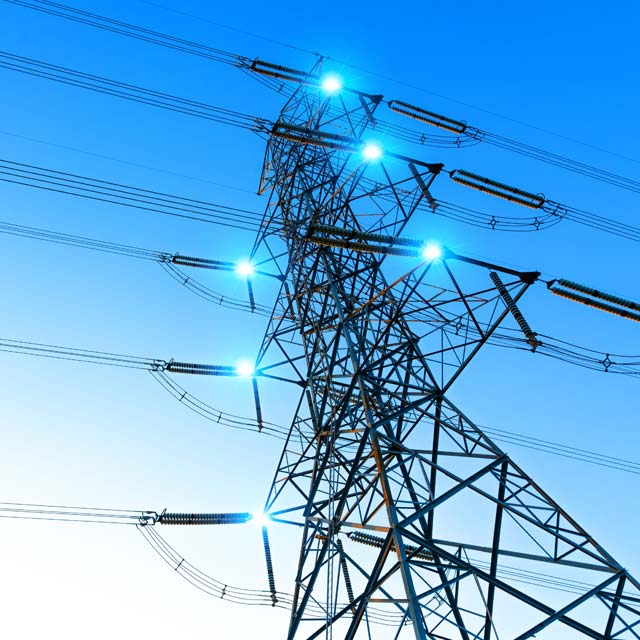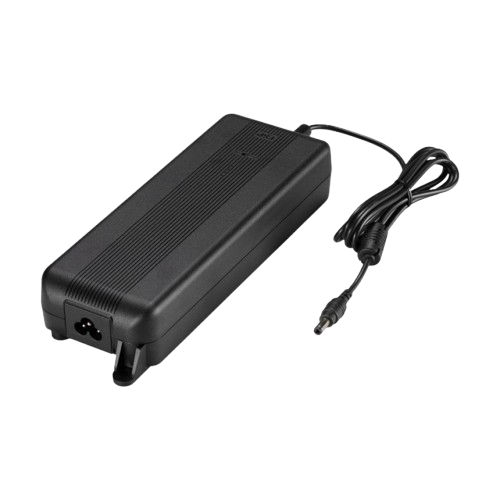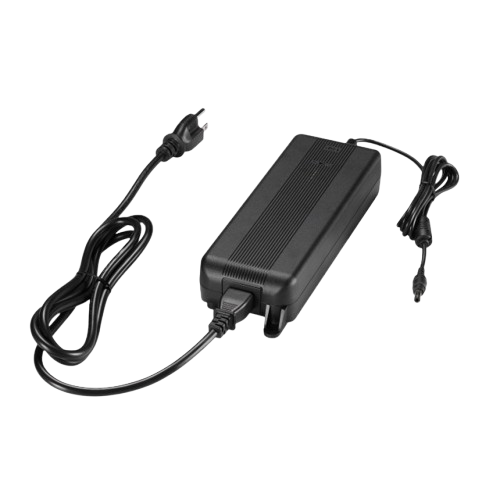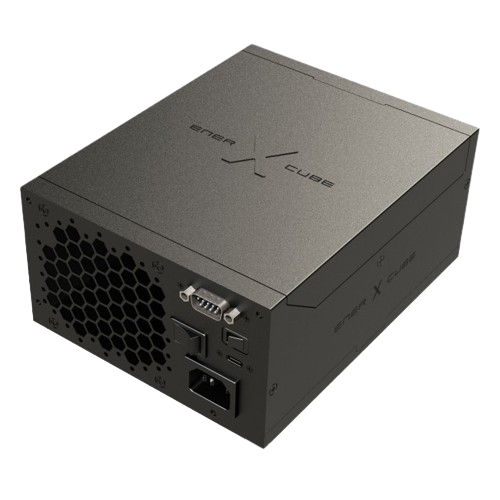Power Outage Fearless: Power Supplies with Battery Backup Ensure Uninterrupted Wireless and Smart Networked Devices

Author: FSP Group
Integrating Battery Backup Technology: Solving Power Outage and Network Disconnection Challenges
In this digital age, network connectivity has become the cornerstone of people's daily lives. Whether it's work emails, video conferences, online learning courses, or data queries, the network plays a critically important role. People rely on the internet to stay connected with the world, remotely manage connected devices, enjoy streaming media services, engage in social media interactions, and conduct online shopping. In fact, in the post-pandemic era, many businesses still allow employees to work from home. How to ensure continuous network and remote connection device operation in the face of insufficient power grid resilience and frequent power outages or brownouts has become a new challenge for people.
When power outages or network failures occur, these connected devices may become inoperable, causing significant inconvenience and worry. Imagine being in an important video conference that suddenly loses network connection, interrupting the high-cost meeting and rendering it ineffective, requiring rescheduling to complete unfinished discussions. Or consider an online learning session that gets cut short due to a power outage. These scenarios not only affect work and learning efficiency but can also bring additional stress and anxiety.
Therefore, power supplies with battery backup have become key components in guaranteeing network connectivity and the continuous operation of networked devices. They can provide stable power during outages, ensuring uninterrupted wireless networks and connected devices, effectively replacing the inconvenience of using Uninterruptible Power Supplies (UPS).
Primary Mission: Ensuring ISP Equipment and Routers Continue Running During Power Outages
A simple network connection and related networked device scenario is as follows: Users typically can choose different internet service provider (ISP) network connection services, such as fiber-to-the-home (FTTH) network services, connecting via FTTH Modem. This approach provides high-speed and stable network connections, with less electromagnetic interference, gradually becoming the current market mainstream. To meet wireless network device access, it's usually paired with a WiFi Router; recently, some ISP providers offer FTTH Modems with built-in WiFi functionality, which is more convenient for users. Some users also choose to connect via cable TV network services using a Cable Modem, which requires connecting through a television coaxial cable and is typically used together with a WiFi Router.
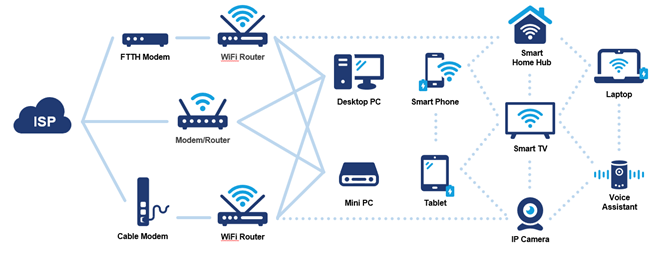
ISP-provided FTTH Modems or Cable Modems usually use 12V power adapters. These power supplies typically have a power output lower than 24W (12V/2A) and are mostly adapter-type. Due to limitations in ISP-provided fiber or coaxial cable access points, with limited placement space, it's challenging to simultaneously place a Modem and WiFi Router and connect a UPS. Without a UPS, there's no continuous stable power support during outages or brownouts. Moreover, most UPS systems still use lead-acid batteries, with the pain point being the need to replace batteries every 2-3 years and perform quarterly battery health tests, which is an additional burden for users.
Understanding users' need for stable continuous power to ensure uninterrupted network connectivity, we've innovatively developed a battery-backed power supply. It's a two-in-one power supply product that provides both AC to DC power conversion and battery backup DC power. The EnerXBar 042-12A (12V/3.5A) is specifically designed for Modems, WiFi Routers, Digital Surveillance, and other 12V power requirements. Using a lithium-ion battery as the Battery Backup Unit, it optimizes the disadvantages of lead-acid batteries such as large size, heavy weight, and short lifespan. It provides zero-interruption (0ms) switching equivalent to an online UPS and can support up to 160% peak output load instantaneously for 1ms, eliminating concerns about network device interruptions during power outages.
No Fear of Power Outages: Keep IP Cameras Recording to Prevent Emergencies
For the safety of certain environments and to handle emergencies promptly, IP cameras can be used in a wide range of scenarios. These cameras not only provide real-time video surveillance but also come equipped with features such as motion detection and night vision to enhance security. Whether used at home, for pet care, or in the workplace, IP cameras effectively prevent unexpected incidents and create a secure monitoring environment. Below are some common use cases:
- Main Entry Points: Installing an IP camera at the main entrance of a home allows for real-time monitoring of entry and exit activities, preventing unauthorized access while ensuring the safety of family members. This is particularly important for protecting elderly individuals and children. For example, monitoring elderly family members to ensure they are moving safely at home or keeping an eye on children while they play.
- Pet Activity Areas: When pets such as cats and dogs are home alone, IP cameras enable owners to check on their pets at any time, ensuring they are safe and not encountering any unexpected dangers. This helps monitor pet activity and detect any unusual behavior.
- Workplace Surveillance: IP cameras installed in workplaces help monitor important areas to prevent incidents. For example, they can be used in warehouses to prevent theft or in offices to ensure employee safety.
Most IP cameras use a 12V adapter as their power supply, similar to many FTTH and cable modems. Their power consumption typically ranges from 10W to 24W, depending on the camera’s features and model. The FSP EnerXBar 042-12A (12V/3.5A) is an excellent choice for these IP cameras, ensuring uninterrupted recording during power outages or electrical failures. Some surveillance systems use PoE (Power over Ethernet) technology, typically paired with an NVR (Network Video Recorder) to form a complete monitoring system. In the future, we plan to introduce backup power solutions specifically designed for these systems to meet customer demands.
Uninterrupted Operation of Smart Home Hubs and Voice Assistants During Power Outages
A Smart Home Hub is a hardware or software platform that serves as the central command system for smart home devices. It allows various smart devices (such as smart thermostats, lights, and locks) to communicate with each other and be managed from a single interface. The primary goal is to unify smart home devices, automate temperature and lighting control, and achieve energy savings.
The primary market for smart home hubs is in North America, where consumers have a high acceptance of smart home technology and strong purchasing power. Other regions, such as the UK, France, Japan, and South Korea, are also gradually adopting these systems. Smart home hubs usually use adapter-type power supplies, with some operating on 5V and others on 12V, typically requiring power between 5W and 24W. For 12V-powered smart home hubs, the FSP EnerXBar 042-12A (12V/3.5A) with battery backup is an ideal power supply solution.
Similarly, Voice Assistants are primarily used in North America, driven by consumer demand for digital convenience and efficiency. These assistants help users with tasks such as online shopping, managing reservations, playing music, sending messages, and setting alarms. Their power supply requirements are similar to smart home hubs, typically using 5V or 12V adapter-type power supplies with power consumption between 5W and 24W. The FSP EnerXBar 042-12A (12V/3.5A) is an excellent choice for voice assistants that require 12V power and battery backup.
Ensuring Stable Operation During Power Outages: Solutions for Mini PCs and AIoT Systems
Mini PCs have gained popularity due to their compact size and high performance. This trend began around 2013 when Intel introduced the Next Unit of Computing (NUC), offering a 4x4-inch motherboard with highly integrated computing capabilities. Mini PCs provide high efficiency, low noise, and low power consumption, making them ideal for home and office use. Over time, their applications have expanded to include AIoT (Artificial Intelligence of Things) and embedded systems, raising concerns about power outages and system stability.
To address this, FSP has developed the EnerXBar 090-19A (19V/4.74A), a battery backup power supply designed for Mini PCs, AIoT, and embedded systems. This power supply provides a zero-interruption (0ms) switchover to battery mode, similar to an online UPS, and supports up to 160% peak power for 1ms, significantly enhancing system performance. Unlike traditional solutions using supercapacitors, which are costly and have limited backup time, this innovative solution ensures uninterrupted operation and stable network connections even during power outages.
How to Maintain Stable Computing During Power Outages: Solutions for Desktop PCs and Workstations
Desktop PCs offer numerous advantages in various scenarios. For instance, at home, they serve as family entertainment hubs, facilitate video editing and multimedia creation, and support large-scale gaming. In office environments, desktop PCs provide stable performance and expandability, making them ideal for handling large amounts of data, performing complex computations, or running multiple applications simultaneously.
Workstation PCs play a crucial role in many professional fields. They are commonly used for CAD (Computer-Aided Design) and CAM (Computer-Aided Manufacturing) applications, enabling complex 3D modeling and design tasks with efficiency and precision. Workstations also serve as essential tools in scientific research and data analysis, handling large datasets and complex computations in fields such as genomics research, climate modeling, and financial data analysis. Additionally, workstations are widely utilized in AI and machine learning, processing vast amounts of data and supporting complex algorithm training with frameworks like TensorFlow and PyTorch.
Both types of PCs typically use ATX 12V V3.1 power supply units (PSUs), with power requirements ranging from a few hundred watts to several kilowatts. While high-end creative workstations and gaming desktops demand more power, most systems operate with PSUs rated at 750W or lower. However, certain applications require continuous operation, making them vulnerable to power outages or electrical disruptions.
As a key industry leader, Intel plays a pivotal role in defining the specifications of critical PC components, including power supplies. Since its inception, FSP Group has been a strategic development partner for Intel in power supply solutions, serving a wide range of customers and understanding their needs. In recent years, an increasing number of customers have sought power backup solutions for uninterrupted operation. Traditionally, the only option was to recommend installing an external UPS (Uninterruptible Power Supply) before the PSU. However, FSP has now introduced an innovative PSU with an integrated battery backup mechanism.
This groundbreaking product not only incorporates a Battery Backup Unit (BBU) but also anticipates the growing adoption of USB PD-powered displays. To address this, the PSU integrates a 65W USB PD output within its casing, providing backup power for USB-powered external monitors, thereby ensuring uninterrupted operation during power outages or fluctuations.
The FSP ATX BBU series includes four power variants:
This series offers a new alternative to traditional UPS solutions for users who require uninterrupted computing. Featuring a safe and high-energy-density Lithium Iron Phosphate (LiFePO₄) battery design, these PSUs provide significantly greater discharge cycle longevity and lifespan compared to conventional UPS lead-acid batteries.
During the initial development phase, FSP collaborated with key long-term partners to refine the product. These partners highlighted broad applications in semiconductor manufacturing, Industry 4.0, and Edge AI Computing, emphasizing the need for a communication interface to monitor electrical parameters and battery status. Additionally, users required the ability to control or shut down the ATX PSU plus BBU remotely. In response, FSP designed the PSU with an RS-232 communication interface for seamless system integration.
This innovative product represents a technological milestone, combining multiple advancements into a single power solution. The FSP ATX BBU series is currently patent pending.
Conclusion
We are living in a dual era of the Internet and AI, where technology has become an integral part of our daily lives, work, and entertainment. Many industries require 24/7 uninterrupted operation, making power reliability a crucial concern.
As AI technology advances, global electricity demand is increasing, raising concerns about frequent power shortages and blackouts. This highlights the importance of battery backup power supplies, which ensure continuous and stable operation for ICT (Information and Communication Technology) devices.
FSP has developed innovative battery backup power supplies to provide stable power during outages, ensuring uninterrupted network connectivity and computing power. Whether for smart home devices, business PCs, or workstations, our solutions provide reliable power backup, allowing users to enjoy the convenience of technology without worrying about power disruptions.
If our existing power supply plus battery backup unit products do not meet your specific needs, please contact us via the "Contact Us form". Provide details about your application, power supply requirements, and expected battery backup time, and we will arrange for a specialist to assist you. Thank you!
Related Articles
About FSP
FSP Group is one of the global leading power supply manufacturer. Since 1993, FSP Group has followed the management conception “service, profession, and innovation” to fulfill its responsibilities as a green energy resolution supplier.

